The Functional Water Market is estimated to be valued at USD 17.2 billion in 2025 and is projected to reach USD 31.4 billion by 2035, registering a compound annual growth rate (CAGR) of 6.2% over the forecast period.
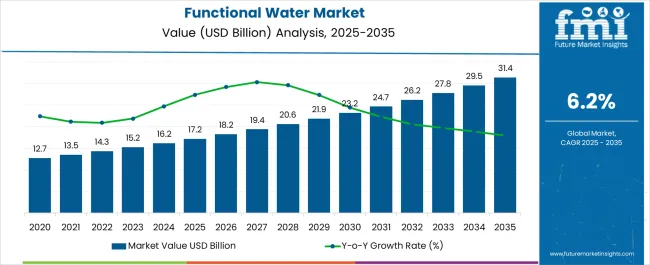
| Metric | Value |
|---|---|
| Functional Water Market Estimated Value in (2025 E) | USD 17.2 billion |
| Functional Water Market Forecast Value in (2035 F) | USD 31.4 billion |
| Forecast CAGR (2025 to 2035) | 6.2% |
The functional water market is expanding steadily due to growing consumer focus on health, wellness, and preventive nutrition. Rising awareness about hydration combined with the benefits of added vitamins, minerals, and electrolytes is driving demand for functional water products.
Shifts in lifestyle patterns, urbanization, and the global movement toward healthier beverage alternatives are further accelerating adoption. Advances in formulation technologies and packaging have enabled manufacturers to deliver nutrient enriched water with improved stability, taste, and convenience.
Regulatory encouragement for low sugar and fortified beverages has also contributed to market growth. The future outlook remains optimistic as functional water continues to be positioned as a premium yet accessible wellness beverage, supported by marketing strategies emphasizing immunity, energy, and overall health benefits.
The market is segmented by Type and Distribution Channel and region. By Type, the market is divided into Vitamin, Protein, and Others. In terms of Distribution Channel, the market is classified into Specialty Stores, Supermarket/Hypermarket, Online Stores, and Others. Regionally, the market is classified into North America, Latin America, Western Europe, Eastern Europe, Balkan & Baltic Countries, Russia & Belarus, Central Asia, East Asia, South Asia & Pacific, and the Middle East & Africa.
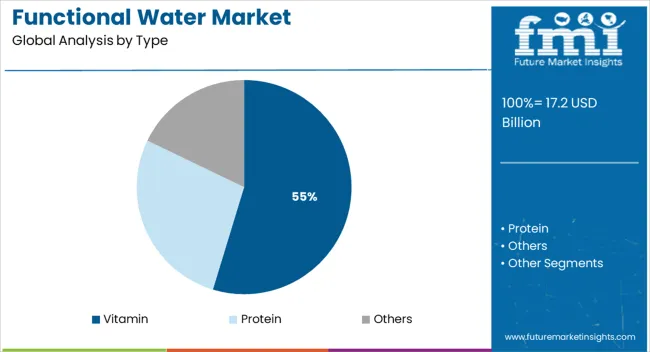
The vitamin type segment is expected to hold 54.70% of total revenue by 2025 within the type category, making it the leading subsegment. Its dominance is driven by rising consumer preference for fortified hydration solutions that deliver added nutritional benefits.
Growing demand for immune boosting and energy enhancing beverages has strengthened the adoption of vitamin infused water. Additionally, the convenience of obtaining essential nutrients in a ready to drink format has appealed to health conscious consumers.
The segment has also benefited from continuous product innovation, such as enhanced flavors and functional blends, which have expanded its consumer base. As wellness continues to be prioritized globally, the vitamin type category has secured its position as the most significant contributor within the functional water market.
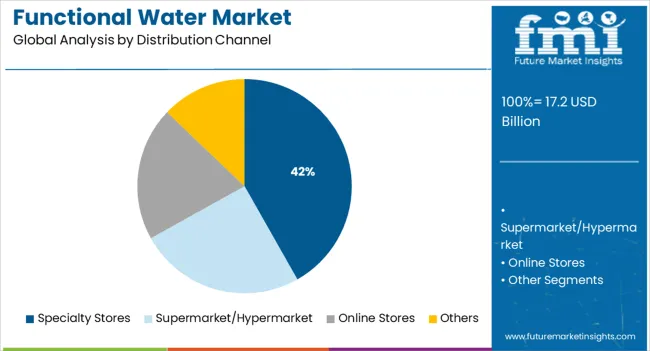
The specialty stores distribution channel is projected to contribute 41.80% of total revenue by 2025, making it the most prominent channel within the market. This dominance is attributed to the ability of specialty stores to provide premium positioning, personalized recommendations, and greater visibility for functional water products.
Consumers seeking healthier beverage alternatives often rely on specialty outlets to access trusted and niche brands. Furthermore, these stores enable promotional campaigns, sampling opportunities, and direct consumer engagement, which have supported higher adoption levels.
The premium and curated shopping experience offered by specialty stores has reinforced their importance in functional water distribution, positioning this channel as the market leader.
The functional water market is expected to be worth USD 17.2 billion by 2025, recording a 7.57% CAGR from 2020 to 2025.
Functional ingredient-enhanced water sales are thus benefiting from the broader consumer trend toward healthy alternatives to artificial and high-sugar drinks. Price is still the most influential element in the purchasing patterns of all functional beverages, including enhanced water; nevertheless, businesses that justify their premium offers with a slew of label claims are projected to earn better sales margins.
The advancement of bottling (packing) technology, combined with a growing retail distribution environment, helps the market for beneficial ingredient-enriched water even further. It contains healthful ingredients such as vitamins, acids, minerals, herbs, and fruits or vegetables, functional water, which is experiencing significant market expansion.
Following the pandemic, customers' focus shifted to correct nutritional consumption, and most consumers shifted to healthy beverage options, such as vitamin- and mineral-infused functional drinks.
In terms of functional water sales, online retail channels are growing prominently than traditional distribution channels, such as supermarkets and specialty stores, and are likely to rise during the forecast period. Furthermore, a shift away from carbonated and high-sugar beverages is further boosting the demand for the functional water industry.
| Historical CAGR (2020 to 2025) | 7.57% |
|---|---|
| Forecast CAGR (2025 to 2035) | 6.2% |
As per the FMI analysts, a valuation of USD 27,281.72 million by 2035 end is estimated for the market.
| 2020 | USD 8.63 million |
|---|---|
| 2024 | USD 14.21 billion |
| 2025 | USD 17.2 billion |
| 2025 | USD 15,234.39 billion |
| 2035 | USD 27,281.72 million |
Manufacturers' development of innovative products and the introduction of new flavors are estimated to boost the global functional water market forward. Portfolio expansion, or new product development, is still one of the most popular tactics among significant industry participants globally.
Consumers are increasingly interested in exotic ingredients and robust flavors that not only appeal to the palate, but are also functional in terms of the whole nutritional profile. B1U has introduced a line of functional infused water that has no sugar or artificial sweeteners.
The introduction of sports drinks, energy drinks, and health drinks cleared the way for the entire movement of function-specific beverages. They provide additional health advantages ranging from improved energy to hydration and probiotic energy. The widespread availability of replacements, such as plant-based waters, which give the same health benefits as functional component enriched water, is expected to stymie the market's expansion.
Following hectic lifestyles, consumers are looking for dietary remedies to alleviate stress, tiredness, and reduced immunity. These solutions take the shape of functional foods, which also serve the purpose of giving nutritional and health benefits. Aside from eating appropriately, consumers are becoming more conscious of the need of drinking correctly.
This is seen in the increased demand for beverages containing substances with health and wellness benefits. Functional beverages, particularly those containing immune-boosting components, may continue to garner attention as consumers seek comprehensive solutions to suit their health and wellness demands.
Increasing Awareness About Healthy Beverages to Drive the Growth of the Market.
The growing prevalence of obesity and growing awareness about healthy lifestyles among the urban population is expected to remain the key drivers governing the growth of the global functional water market. Functional water consumers are conscious about their environment’s safety, as reports have shown that plastics are non-biodegradable pollutants whose presence has a detrimental effect on the environment.
With governments’ stringent regulations regarding plastics, manufacturers in the industry are prompted to develop new and innovative materials to package their products. Consumers are sometimes attracted to the functional water market by the type of package used by different leading companies. Furthermore, growing consumers’ demand for fortified food and beverages is estimated to foster the rise in demand for functional water in a few years.
Sales are expected to increase drastically, as the population of diabetes and obesity patients is rising annually, threatening the global world. Countries like the United States, the United Kingdom, China, India, and Australia have increased the production of functional water, as consumers have switched their preference from consuming carbonated soft drinks to packaged water.
The global functional water market growth is expected to be hampered during the forecast period due to the hike in the price of the PET bottles used in packaging functional water. Also, the stringent regulations related to food safety are expected to limit the growth of the functional water market.
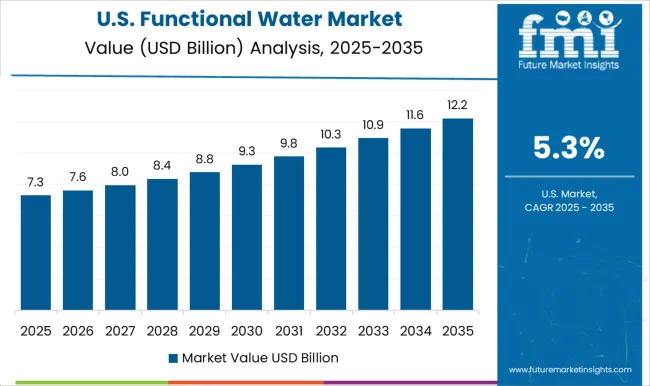
The Presence of Leading Market Players in the Region Arise Opportunities for the Market
North America dominated the global functional water market in 2025. North America accounts for a market share of 33.7% in the global functional water market. North America for instance currently has dominance, backed by robust growth in the demand from the United States. Sales of bottled water have already surpassed that of soft drinks in the country, prompting companies to expand their functional offerings.
For instance, a new range of beverages from Evian is available in four different flavors - raspberry & ginseng, lime & ginger, grapefruit & basil, and cucumber & mint. These drinks have zero sugar and are zero-calorie drinks enriched with zinc and magnesium, currently available in the United States.
The rising demand for functional water in North America is causing a subsequent shift in the beverage industry. Various leading brands are joining the bandwagon to offer a functional hydration experience to consumers. As a result, there is a high focus on innovating compositions of beverages to lure consumers in favor of purchasing it.
Growing Spending Power of Consumer Base in the Region to Drive Market Growth
According to Future Market Insights, Europe is expected to provide immense growth opportunities for the functional water market, consumers in the region are on the rise, which is estimated to facilitate the industry's growth. Europe's functional water market accounts for a 40.6% share of the total global market.
The increased consumers' disposable income is slated to fuel the growth of the functional water market during the forecast period. Also, increasing health concerns of consumers are detaining them from consuming artificially flavored beverages and carbonated drinks, and the popularity of functional water is growing in the region.
Growing E-commerce Sector in the Region Boosts the Functional Water Market in the Coming Years
The functional water market in the Asia Pacific is projected to expand at a significant pace during the forecast period, due to the presence of emerging economies in Asia like China and India, and rapid urbanization in the region eventually leads to the adoption of a sophisticated lifestyle.
The prevalence of e-commerce platforms in the APAC is attracting huge stakeholders’ attention. Moreover, booming digitization, coupled with the convenience of e-Commerce platforms in developing countries such as India is offering a conducive ground for functional water manufacturers. However, considering the total population in Asia Pacific, it is likely that market players are going to target the countries in the region highly.
As a result of increasing awareness, consumers in Asia Pacific have become eagerly willing to spend on functional water. For instance, Danone S.A. is channelizing its effort to penetrate deep across high-potential markets in the Asia Pacific, where it is aiming for double-digit growth on the back of improved sales of bottled water recorded in the region.
The new entrants in the functional water market are continually indulging in several collaborations and highly investing in research and development activities to provide more convenient solutions to industry verticals.
Some of the key start-ups that are leading the development of the market are, Funkthedrink, Ugly Drinks, Focus Water, OSHEE, Diva’s Drink, Viwa Vitamine Water, Herbal Water, and Miami Bay Beverage LLC
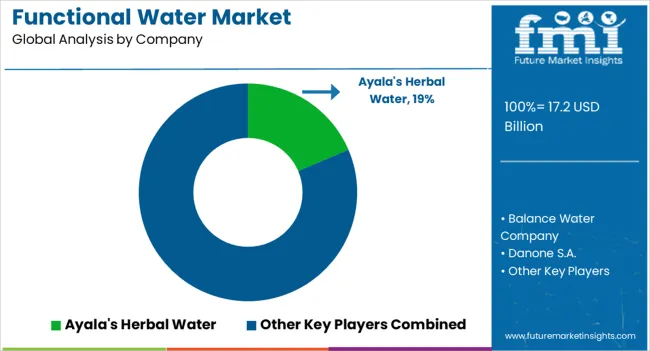
Prominent Players in the market
| Attribute | Details |
|---|---|
| Market Size Value in 2025 | USD 17.2 billion |
| Market Size Value in 2035 | USD 31.4 billion |
| Market Analysis | USD million for Value |
| Key Region Covered | North America; Latin America; Europe; Asia Pacific; The Middle East and Africa |
| Key Segments | By Type, By Distribution Channel, By Region |
| Key Companies Profiled | Danone; Coca-Cola; Pepsico; Dr. Pepper Snapple Vitamin Well AB; Triamino Brands LLC; New York Spring; Herbal Water; Vichy Catalan Corporation; San Benedetto; Unique Foods (Canada) |
| Report Coverage | Market Forecast, Company Share Analysis, Competition Intelligence, DROT Analysis, Market Dynamics and Challenges, and Strategic Growth Initiatives |
| Customization & Pricing | Available upon Request |
The global functional water market is estimated to be valued at USD 17.2 billion in 2025.
The market size for the functional water market is projected to reach USD 31.4 billion by 2035.
The functional water market is expected to grow at a 6.2% CAGR between 2025 and 2035.
The key product types in functional water market are vitamin, protein and others.
In terms of distribution channel, specialty stores segment to command 41.8% share in the functional water market in 2025.






Full Research Suite comprises of:
Market outlook & trends analysis
Interviews & case studies
Strategic recommendations
Vendor profiles & capabilities analysis
5-year forecasts
8 regions and 60+ country-level data splits
Market segment data splits
12 months of continuous data updates
DELIVERED AS:
PDF EXCEL ONLINE
Functional Multi-Layer Coextruded Film Market Size and Share Forecast Outlook 2025 to 2035
Functional Plating Chemicals Market Size and Share Forecast Outlook 2025 to 2035
Functional Flours Market Size and Share Forecast Outlook 2025 to 2035
Functional Flour Market Size and Share Forecast Outlook 2025 to 2035
Functional Endoscopic Sinus Surgery Systems Market Size and Share Forecast Outlook 2025 to 2035
Functional Foods Market Size and Share Forecast Outlook 2025 to 2035
Functional Safety Market Size and Share Forecast Outlook 2025 to 2035
Functional Printing Market Size and Share Forecast Outlook 2025 to 2035
Functional Seafood Market Size and Share Forecast Outlook 2025 to 2035
Functional Textile Finishing Agents Market Size and Share Forecast Outlook 2025 to 2035
Functional Pet Ingredients Market Analysis - Size, Share, and Forecast Outlook 2025 to 2035
Functional Cosmetic Ingredients Market Size and Share Forecast Outlook 2025 to 2035
Functional Food Ingredients Market Analysis – Size, Share, and Forecast Outlook 2025 to 2035
Functional Flavour Market Analysis - Size, Share, & Forecast Outlook 2025 to 2035
Functional Extracts Market Analysis – Size, Share, & Forecast Outlook 2025 to 2035
Functional Chewing Gum Market Analysis - Size, Share, & Forecast Outlook 2025 to 2035
Functional Carbohydrate Market Analysis -Size, Share, & Forecast Outlook 2025 to 2035
Functional Mushroom Market Size, Growth, and Forecast for 2025 to 2035
Functional Protein Market Analysis - Size, Share, and Forecast Outlook 2025 to 2035
Functional Electrical Stimulation (FES) Market Trends - Growth & Forecast 2025 to 2035

Thank you!
You will receive an email from our Business Development Manager. Please be sure to check your SPAM/JUNK folder too.
Chat With
MaRIA